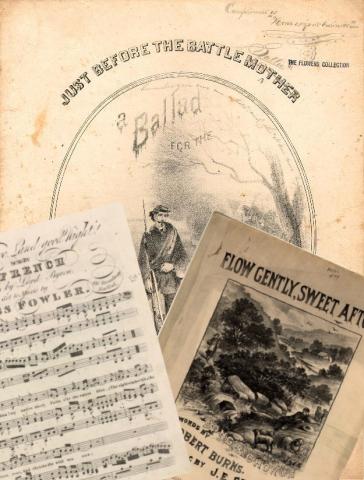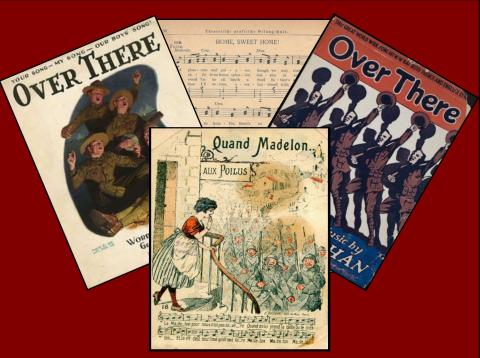
Music in Willa Cather's Writing
While not a musician herself, Willa Cather was an avid musical consumer! She frequented the opera, developed acquaintances and friendships with the leading musicians of her day, and wrote them into her novels, short stories, and reviews. It's inevitable, maybe, that playlists exploring Cather's musical allusions would be developed. Streaming 21st-century music based on a century-old novel, however, is challenging. These playlists capture the essence of Cather's context and enlighten listeners about the meaning of Cather's inclusion in her own writing. Each selection here is referenced in Cather’s writing, though they are not always in order, if you're reading along with the novel.
In addition to serving to help readers better understand Cather and her world, the playlists are wonderful companions on your daily commute! Enjoy!
The Song of the Lark

Part I: "Friends of Childhood"
The playlist developed in conjunction with Part I of The Song of the Lark reflects the colorful people and cultures in which the irrepressible Thea Kronborg immerses herself as she is growing up in Moonstone, Colorado, a fictional community based on Cather’s hometown of Red Cloud, Nebraska. Characters like Spanish Johnny, Herr Wunsch, Dr. Archive, and railroad worker Ray Kennedy all nurtured and inspired Thea’s spirited talent. Their friendship, encouragement, and even the occasional rebuke become a springboard for Thea's musical education in Chicago.
Part II: "The Song of the Lark"
The playlist for Part II of The Song of the Lark portrays Thea Kronborg’s coming of age amidst continued piano study, church music work, and transition to vocal music. As she enters the world of formal study in the urban Chicago landscape, her musical parameter shifts to a classic, academic focus, while the tapestry of styles experienced in Part I of the novel fades into the background.
Part III: "Stupid Faces"
Part IV: "The Ancient People"
The music serving as backdrop to Part III of The Song of the Lark mirrors Thea’s shift from piano to vocal studies, although her work as an accompanist and church musician continues as a means of financial support. The frenetic pace of work and study leads the young artist to the brink of defeat, as her sensitive, artistic spirit is overshadowed by a drive to perfect her musical skills.
Part IV finds Thea fleeing the pressure of a professional career. She travels to the canyons of northern Arizona, relishing time spent in the natural beauty of the ancient cliff dwellings, where she begins to recover her once-indomitable spirit. Scarce mention is made of music in Part IV; figuratively speaking, Canto IV of Childe Harold’s Pilgrimage, referenced elsewhere in the novel, seems especially fitting for this season of Thea’s life.
Part V: "Doctor Archie's Venture"
Part VI: "Kronborg" and Epilogue
The playlist for Parts V and VI of The Song of the Lark highlights Thea Kronborg’s ascent to the height of her musical career. She lands the plum role of Sieglinde in Richard Wagner’s Die Walküre. In the audience for her stunning performance are friends from her childhood days in Moonstone, as well as the teacher who discovered her vocal talents. Two musical renderings of the Scottish folk song, “Ca’ the Yowes to the Knowes” light the way for Cather’s epilogue, again set in Moonstone. These, along with a final folk ballad may seem an incongruous pairing with the operatic music of Parts V and VI, but they bring the story of Thea's success full circle. The diversity Kronborg’s early life emerge with these closing numbers.
One Of Ours

Symbolism of Music in the Shadows
Willa Cather’s Pulitzer prize-winning novel One of Ours is based on the life of her cousin Grosvenor Phillips Cather, who perished in 1918 at the Battle of Cantigny, France, during World War I. One of Ours is divided into five books, with music conspicuously absent from the first three, according to Richard Giannone, author of Music in Willa Cather’s Fiction. Giannone maintains that the dearth of music symbolizes the lack of fulfillment in the life of Claude Wheeler, the fictional version of Cather’s cousin. Claude’s young adulthood is devoid of satisfaction in education, work, place, spirituality, and family and marital relationships.
In developing a playlist for this portion of the book, some selections were made without Cather's explicit reference. For example, in Book I, Chapter X, Madame Schroeder-Schatz sings for Claude and the Ehrlich family, although Cather makes no mention of a specific musical number. One potential prototype for Madame Schroeder Schatz was the enigmatic opera singer Ernestine Schumann-Heink, so her performance of “Wiegenlied” was chosen for this list.
Novel's Progression Brings Music to Foreground
Music emerges from the shadows in Book IV, “The Voyage of the Anchises,” as Claude embarks on military service that takes him across the Atlantic Ocean to France. This segment is both jubilant, as Claude breaks from his unhappy surroundings, and grim, as influenza besets his troopship. In Book V, “Bidding the Eagles of the West Fly On,” as Claude embraces nobility of purpose as a soldier and his love for France and its people, Claude’s love of music explored through his friendship with an acclaimed violinist-turned-soldier.
Ultimately, Claude Wheeler died in France, just as Cather’s cousin did. “He died believing his own country better than it is, and France better than any country can ever be. And those were beautiful beliefs to die with,” Cather wrote in One of Ours. In a letter to her Aunt Frances, Cather wrote that G.P. “died a glorious death in a great cause.” G.P. Cather was posthumously awarded the Distinguished Service Cross. Despite the Cather family’s desire for France as his final resting place, Grosvenor’s widow arranged to have his body returned to the states for burial at East Lawn Cemetery in Bladen, Nebraska.
Companion Playlist Highlights Musical Event in Cather's Life
Renowned violinist David Hochstein (1892-1918) was the prototype for fictional David Gerhardt, friend of Claude Wheeler, in Cather’s One of Ours. “I wanted my red-headed soldier from a prairie farm to 'get some of his back,' . . . through a fine friendship,” Cather said in a New York Herald interview published December 24, 1922. During the course of the interview, Cather spoke of having met Hochstein on three occasions, the first in 1916 when a group of musician friends gathered in New York's Wellington Hotel. “They played a lot of chamber music that afternoon, Schubert's Death and the Maiden among other things, but what I particularly remember was their beautiful playing of Schubert's Die Forelle (The Trout) . . .” said Cather. Our second playlist is built around Cather's memorable afternoon of music with Hochstein and friends. Tragically, the violinist was killed in the Battle of Argonne while serving with the United States Army.
